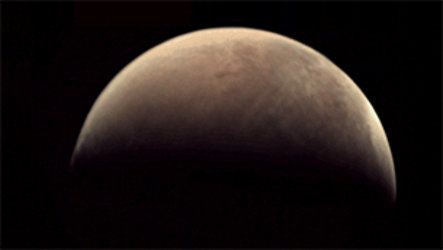Astronaut's eye view: Mars Express orbiting the Red Planet
This video shows what future astronauts would see from their cockpit: Mars turning below as they sweep around the Red Planet. Last month, ESA's Mars Express snapped images every minute to create a unique video that loops through a complete orbit of Earth's gorgeous neighbour.
Mars holds a special fascination for humans. Its relative proximity and its solid surface make it a tantalising target for exploration. Thanks to this new video from Mars Express, we can now imagine what it will be like to orbit the Red Planet some day, possibly searching for a place to land.
Last month, mission controllers commanded the Visual Monitoring Camera (VMC) to acquire an image of Mars every minute during one complete, 7-hour orbit. The VMC is a low-resolution, non-scientific digital camera originally used only to confirm separation of the Mars Express lander in 2003.
The resulting still images have been combined to create a unique video as Mars Express loops between its greatest height above the surface, 10 527 km, to its lowest, at just 358 km, and back again. This is the first such video ever generated from a spacecraft orbiting Mars.
A constellation of giant volcanoes
The giant volcanoes of Mars can be clearly seen at the start of the video, visible as a constellation of dark spots on the desert surface. They are followed by a glimpse of the Argyre Planitia, lying just north of the southern polar circle, before the spacecraft plunges into the darkness of the planet's night side. Daylight returns with a soaring ride over the spiral ices of the North Pole.
Near the beginning and end of the video, as Mars Express slows down during the highest arc of its orbit, Mars can be seen rotating on its axis. At the very end, Phobos passes far beneath Mars Express, and the tiny moon's disc can be seen as a dark circle moving from top to bottom in the movie.
The video clearly illustrates the highly elliptical orbit of Mars Express, with the journey around the planet starting slowly at high altitude and gaining speed as the altitude lowers.
It also shows how Phobos orbits Mars as well as numerous geographic features on the surface. The fact that the viewer enters darkness on the night side and comes back out on the morning side (and can see surface features rotating into the light) also shows how night and day are created by a planet's rotation, just like our own dusk and dawn on Earth.
Seven-hour orbit and 600 raw images
The images used to generate the video, 600 in total, were acquired during the 8194th orbit on 27 May 2010 between 02:00 and 09:00 UTC (03:00-10:00 CEST) and were transmitted to Earth a few hours later via ESA's 35 m-diameter New Norcia deep space antenna in Australia.
This unique video was produced through a cooperative effort between the scientists and mission controllers who care for Mars Express during its regular daily scientific exploration activities.
Click here to access downloadable versions of these animations.
More information on the VMC, additional versions of this video and an archive of past images are available in the VMC - the Mars Webcam dedicated website.















 Germany
Germany
 Austria
Austria
 Belgium
Belgium
 Denmark
Denmark
 Spain
Spain
 Estonia
Estonia
 Finland
Finland
 France
France
 Greece
Greece
 Hungary
Hungary
 Ireland
Ireland
 Italy
Italy
 Luxembourg
Luxembourg
 Norway
Norway
 The Netherlands
The Netherlands
 Poland
Poland
 Portugal
Portugal
 Czechia
Czechia
 Romania
Romania
 United Kingdom
United Kingdom
 Slovenia
Slovenia
 Sweden
Sweden
 Switzerland
Switzerland


























